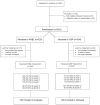All Nations Breath of Life: A Randomized Trial of Smoking Cessation for American Indians
- PMID: 27436332
- PMCID: PMC5067178
- DOI: 10.1016/j.amepre.2016.05.021
All Nations Breath of Life: A Randomized Trial of Smoking Cessation for American Indians
Abstract
Introduction: American Indians have the highest cigarette smoking prevalence of any racial/ethnic group in the U.S. There is currently no effective empirically based smoking-cessation program for American Indians. The purpose of this study was to determine if a culturally tailored smoking-cessation program, All Nations Breath of Life (ANBL), is more effective than a non-tailored cessation program among American Indian smokers.
Design: A multisite RCT was conducted from September 2009 to July 2014; analysis was conducted in 2015.
Setting/participants: Participants were rural or reservation-based American Indian smokers aged ≥18 years.
Intervention: Smokers were group randomized to either the culturally tailored ANBL or non-tailored current best practices (CBP) for a total enrolled sample size of 463 (ANBL, n=243; CBP, n=220).
Main outcome measures: The primary outcome of interest was salivary cotinine-verified 7-day point prevalence smoking abstinence at 6 months. Results for both responder-only and intent-to-treat analyses for self-reported and cotinine-verified abstinence are presented.
Results: Intention-to-treat, imputing all non-responses as smokers, the self-reported point prevalence abstinence rates at 12 weeks were 27.9% in the ANBL arm and 17.4% in the CBP arm (p=0.028). There was a statistically significant difference in self-reported 6-month intent-to-treat point prevalence abstinence rates between ANBL (20.1%) and CBP (12.0%) arms (p=0.029). None of the cotinine-verified results were statistically significant.
Conclusions: The culturally tailored smoking-cessation program ANBL may or may not be an effective program in promoting cessation at 12 weeks and 6 months. Participants in the culturally tailored ANBL program were approximately twice as likely to quit smoking at 6 months compared with the CBP program, using self-reported abstinence.
Copyright © 2016 American Journal of Preventive Medicine. Published by Elsevier Inc. All rights reserved.
Figures
References
-
- Redwood D, Lanier AP, Renner C. Differences in cigarette and smokeless tobacco use among American Indian and Alaska Native people in Alaska and the Southwest United States. Nicotine Tob Res. 2010;12(7):791–796. http://dx.doi.org/10.1093/ntr/ntq087. - DOI - PMC - PubMed
-
- Okuyemi K, Cox LS, Choi WS, Ahulwalia JS. Smoking Cessation in U.S. Ethnic Minority Populations. Vanguard Conference: Building on Success in Smoking Cessation; 2004; San Francisco.
-
- Moghaddam JF, Dickerson DL, Yoon G, Westermeyer J. Nicotine dependence and psychiatric and substance use disorder comorbidities among American Indians/Alaska Natives: Findings from the National Epidemiologic Survey on Alcohol and Related Conditions. Drug Alcohol Depend. 2014;144:127–133. http://dx.doi.org/10.1016/j.drugalcdep.2014.08.017. - DOI - PubMed
-
- Cobb N, Espey D, King J. Health behaviors and risk factors among American Indians and Alaska Natives, 2000–2010. Am J Public Health. 2014;104(Suppl 3):S481–489. http://dx.doi.org/10.2105/AJPH.2014.301879. - DOI - PMC - PubMed
Publication types
MeSH terms
Grants and funding
LinkOut - more resources
Full Text Sources
Other Literature Sources
Medical


